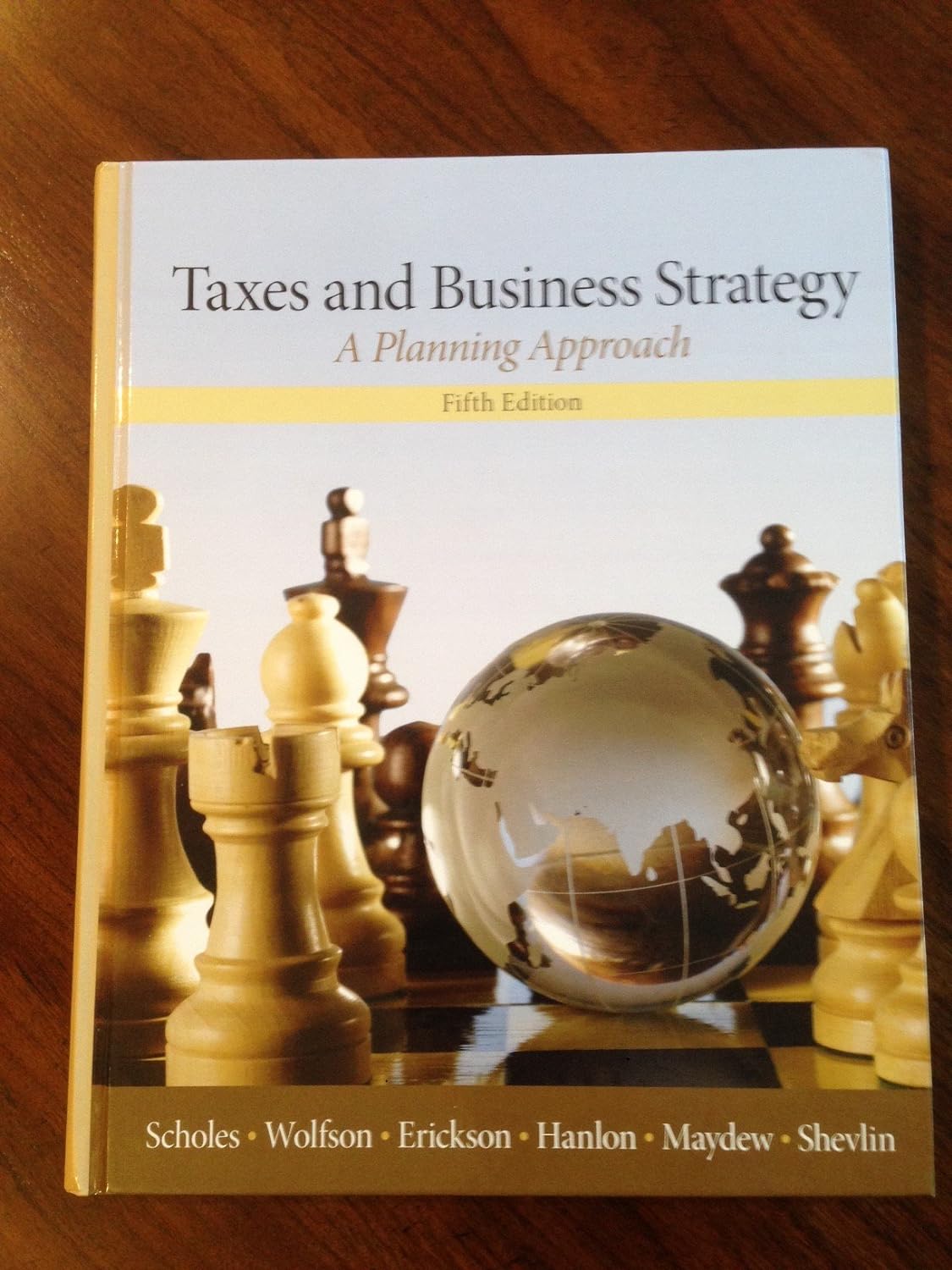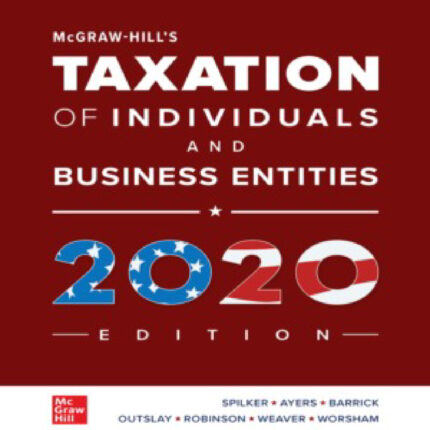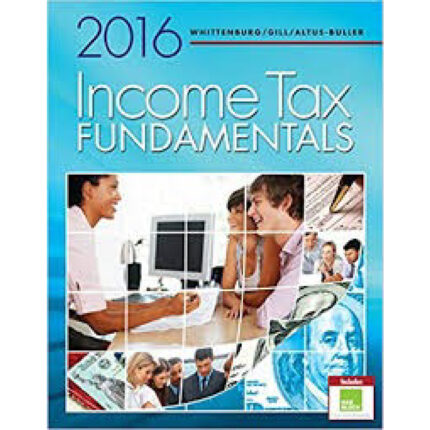Exercises (amounts in $ millions)
- a. U.S. tax before FTC = 5000 x .35 = 1750
FTC = min(1000 x .35, 280) = 280
U.S. tax after FTC = 1470
Worldwide tax = 1470 + 280 = 1750
- U.S. tax before FTC = 1750
FTC = min(1000 x .35, 200) = 200
U.S. tax after FTC = 1550
Worldwide tax = 1550 + 200 = 1750
The foreign tax planning does not affect the firm’s worldwide tax burden.
- Yes. If the firm faces a large foreign tax rate increase in the next year, then it may face a binding FTC limitation next year. Reducing foreign taxes paid in the current year increases the excess FTC limitation in the current year and would allow for more FTC carrybacks from next year.
- a. U.S. tax before FTC = 2000 x .35 = 700
FTC = min(500 x .35, 200) = 175
U.S. tax after FTC = 525
Worldwide tax = 525 + 200 = 725
- U.S. tax before FTC = 700
FTC = min(500 x .35, 150) = 150
U.S. tax after FTC = 550
Worldwide tax = 550 + 150 = 700
With a binding FTC limitation reducing foreign taxes can reduce the firm’s worldwide tax burden.
- a. U.S. tax before FTC = 1000 x .35 = 350
FTC = min(200 x .35, 100) = 70
U.S. tax after FTC = 280
FTC carryover = 30
- U.S. tax before FTC = 1000 x .35 = 350
FTC = min(500 x .35, 120 + 30) = 150
U.S. tax after FTC = 200
FTC carryover = 0
- a. U.S. tax before FTC = 1300 x .35 = 455
FTC = min(800 x .35, 300 + 20) = 280
U.S. tax after FTC = 175
- U.S. tax before FTC 455
FTC passive = min(200 x .35, 20) = 20
FTC general = min(600 x .35, 300)= 210
U.S. tax after FTC 225
Restriction on averaging of high and low tax foreign income for FTC purposes decreases the firm’s FTCs.
Tax Planning Problems (amounts in $ millions)
- a. U.S. tax before FTC = 200 x .35 = 70
FTC = min(100 x .35, 20) = 20
U.S. tax after FTC = 50
- U.S. tax before FTC = 300 x .35 = 105
FTC = min(200 x .35, 65) = 65
U.S. tax after FTC = 40
- Same $50 in U.S. taxes.
- U.S. tax before FTC = 105
FTC general (100 x .35, 20) = 20
FTC passive (100 x .35, 45) = 35
U.S. tax after FTC = 50
- a. FTC = min (FTC limit, 100 x .40)
FTC limit = min (100 / (100-30) , 1) x 70 x .35 = 24.5
FTC = min (24.5, 40) = 24.5. Produces 15.5 of FTC carryforward.
U.S. tax = (100 – 30)(.35) – 24.5 = 0
- FTC = min (100 x .35, 40) = 35. Produces 5 of FTC carryforward.FTC carryforward from prior year not able to be used this year.
U.S. tax = (100 + 150)(.35) – 35 = 52.5
- Year 1 FTC = min (100 x .35, 40) = 35. Produces 5 of FTC carryforward.
Year 1 U.S. tax = (100 x .35) – 35 = 0
Year 2 FTC = min (100 x .35, 40) = 35. Produces 5 of FTC carryforward.
Year 2 U.S. tax = (100 + 150 – 30)(.35) – 35 = 42
The income shifting between years increased the FTC by 10.5 (52.5 to 42). This is an example of international tax rules causing intertemporal (rather than cross-jurisdictional) income shifting.
- a. U.S. tax before FTC = 500 x .35 = 175
FTC = min(200 x .35, 40) = 40
U.S. tax after FTC = 135
Worldwide tax = 40 + 135 = 175
- U.S. tax before FTC = 175
FTC = min(200 x .35, 70) = 70
U.S. tax after FTC = 105
Worldwide tax = 105 + 70 = 175
- U.S. tax before FTC = 175
FTC = min(200 x .35, 100) = 70
U.S. tax after FTC = 105
Worldwide tax = 105 + 100 = 205
- U.S. tax before FTC = 175
FTC = min(260 x .35, 130) = 91
U.S. tax after FTC = 84
Worldwide tax = 84 + 130 = 214
The income shifting increases the firm’s worldwide taxes by $9 million – a bad idea.
- U.S. tax before FTC = 175
FTC = min(260 x .35, 100) = 91
U.S. tax after FTC = 84
Worldwide tax = 84 + 100 = 184
The income shifting saves the firm $21 million by increasing the FTC limitation without increasing the actual foreign taxes paid.
- a. Let tw = withholding tax rate; tf = foreign tax rate
Each dollar of dividend received must be “grossed up” to include the foreign taxes paid:
$1/[(1-tw)(1-tf)] = $1/[(1-.20)(1-.25)] = $1.67
- The total foreign tax rate is 40%. This consists of a 25% local tax rate and a 20% withholding tax on 75% of the income (the amount left over after a 25% local tax). Since the foreign tax rate exceeds the U.S. rate, no additional U.S. tax liability will result from a dividend.
Each dividend received triggers $1.667 of U.S. taxable income. The U.S. tax on this @ 35% is $.583. The foreign tax credit is the minimum of $.583 and the foreign tax paid of $.667. So no additional U.S. tax is triggered. In fact, there is an $.08 foreign tax credit carryforward ($1.67 x (40% – 35%)).
Each dollar of profit earned abroad and repatriated now yields a $.60 dividend that attracts no additional U.S. corporate tax. If the foreign subsidiary were capitalized with debt rather than equity, and all profits were repatriated by way of interest rather than dividends, then each dollar of profit would trigger $.65 of after-tax income. This is so whether the withholding tax rate on interest payments is 0% or 30%. In the latter case, each dollar of gross interest would attract $.30 of withholding tax, and the U.S. parent would receive only $.70 in net interest. The $.70 receipt would trigger one dollar of taxable income, a tax of $.35, and a foreign tax credit of $.30. The additional U.S. tax would be $.05, and the after-tax income would be $.70 – $.05 or $.65. This is 8% higher than the $.60 available from an all-equity-financed investment.












Reviews
There are no reviews yet.